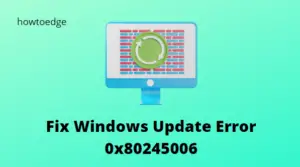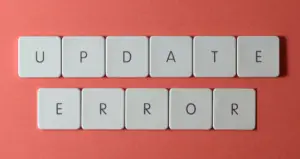Sometimes when you try to install certain updates on Windows PC, it may get failed with an error code 800F0A13. Some users have experienced this issue with multiple updates while others are reporting that it is only associated with one particular update.
Generally, the issue affects Windows 7 users. However, occurrences of the issue have also been reported on Windows 8.1 and 10. Windows Update Error Code 800F0A13 can be caused by many things, but the corrupted system file is the primary cause of this error code.
This error comes with an error message – Error(s) found: Code 800F0A13 Windows Update ran into a problem.

What Causes the Windows Update Error Code 800F0A13?
There might be multiple different factors that cause this error message. Here are some culprits that could cause this issue:
- This error most likely arises from a genetic problem that Microsoft has already documented. The issue can be resolved by executing the Windows Update Troubleshooter tool and applying the recommended fix.
- There is a possibility that the issue may be caused by a corrupted system file that affects Windows Update. In this case, you can fix the problem by running DISM and SFC utility. It can fix corrupted OS components.
- If you’re running an antivirus program from a third party, there’s a good chance it has extra protective features and interferes with Windows Update. If this is the case, you can fix the error by disabling third-party interference.
- A corrupt kernel process, startup item, or background task of your operating system can result in this error code. In order to resolve these, you’ll have to do a startup repair.
How to Fix Windows Update Error Code 800F0A13?
If you are experiencing Windows Update Error Code 800F0A13 and seeking solutions, you might want to try the following suggestions:
- Run the Windows Update Troubleshooter
- Remove third-party application
- Run DISM and SFC utility
- Troubleshooting in Clean Boot State
- Perform a Startup Repair
1] Run the Windows Update Troubleshooter
Running the update troubleshooter may be helpful if you’re encountering error code 800F0A13 on your computer. The following steps will help you troubleshoot Windows –
For Windows 11
- Press the Windows+I keys to open the Settings menu.
- Select the System tab from the left pane.
- Scroll down the right page and select Troubleshoot.
- Select “Other troubleshooters” on the next page.

- Click the Run button next to Windows Update.

For Windows 10
- Use the shortcut Windows key + I to open Settings.
- Then click on Update & Security > Windows Update.
- On the right side of the window, click “Additional troubleshooters.”

- Now click the Run troubleshooter button under Windows Update.
- Continue the process by following the on-screen instructions.
- Once it appears with a solution, click on Apply this fix button.
2] Remove the third-party application
In case you have recently installed a third-party application, it might not be compatible with Windows and resulting in this error code. To solve this error, try disabling this application and see if it helps.
- Right-click on the Start menu and select Settings from the option list.
For Windows 11: Go to Privacy & Security> Windows Security > Virus & threat protection.
For Windows 10 – Navigate to Update & Security > Windows Security > Virus & threat protection.
- Click the “Manage settings” link under Virus and threat protection settings.
- Next, turn off the Real-time protection button.
- Now temporarily disable the third-party applications that you are using.
When you’ve completed the above steps, restart your computer to see if you’re now able to update Windows.
3] Run DISM and SFC utility
DISM and System File Checker can be used to diagnose corrupted system files. So, if you are still experiencing the same error code, give it a try. These are the steps to use these tools:
- Right-click on Start and select Command Prompt (Admin) from the menu list.
- When UAC prompts on the screen, click Yes.
- Enter the below command in the command prompt and hit Enter –

sfc /scannow
- Keep running the scan until it hits 100%.
- Once this has been done, copy and paste the following command and press Enter –

DISM.exe /Online /Cleanup-Image /Restorehealth
- This process will take another 15 to 20 minutes to scan and repair the corrupted Windows image.
Once the process has been completed, restart your computer.
5] Troubleshooting in Clean Boot State
Sometimes, the reason for Windows Update issues is actually caused by a third-party application. In this case, you’ll need to perform a clean boot so that only the most important files and services can be loaded. To perform a clean boot of Windows, follow these steps:
- Open the Start menu, type System Configuration and press Enter.

- Switch to the Services tab and tick the box next to Hide all Microsoft services.
- Then click on the “Disable all” option.
- Click on the Apply button and go to the Startup tab.
- Here click on the link stating Open Task Manager.
- Next, you should be on the Startup tab in Task Manager.

- Then each startup service should be selected individually, and then click on Disable.
- Start your computer again and see if that solves the problem.
- If the problem persists, open System Configuration once again.
- On the General tab, check the Load system services box.
- Once the customizations have been made, click the Apply > OK button and restart your computer.
- Now that the problem has been fixed, you can enable the services one by one.
6] Perform a Startup Repair
When nothing seemed to work, you have probably encountered corruption that cannot be resolved conventionally. In situations like this, running a Startup Repair might be helpful.
- Press the Win+I keys to open the Windows Settings.
- For Windows 11, go to System > Recovery.
- For Windows 10, navigate to Update & Security > Recovery.
- Scroll down to the Advanced startup and click the “Restart now” button.

- On the next screen, select Troubleshoot > Advanced options.

- Then choose to Automatic Repair or Startup Repair option.
- Now choose an account to continue.
- Enter the password for the account and then click Continue.
Now, Windows will analyze the issue and attempt to fix it. This process may take quite a while, and your system may even boot during this process.



